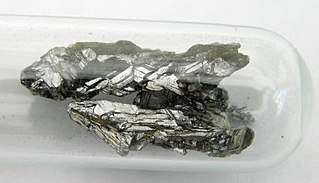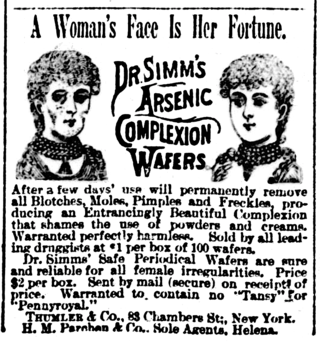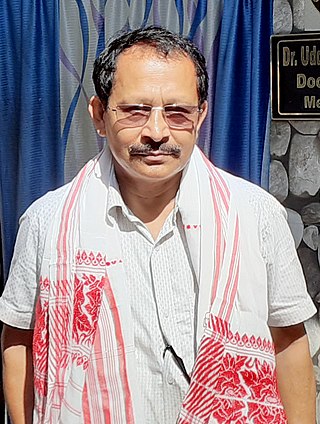Related Research Articles

Arsenic is a chemical element with the symbol As and atomic number 33. Arsenic occurs in many minerals, usually in combination with sulfur and metals, but also as a pure elemental crystal. Arsenic is a metalloid. It has various allotropes, but only the grey form, which has a metallic appearance, is important to industry.

Dean Lawrence Kamen is an American engineer, inventor, and businessman. He is known for his invention of the Segway and iBOT, as well as founding the non-profit organization FIRST with Woodie Flowers. Kamen holds over 1,000 patents.

Arsenic poisoning is a medical condition that occurs due to elevated levels of arsenic in the body. If arsenic poisoning occurs over a brief period of time, symptoms may include vomiting, abdominal pain, encephalopathy, and watery diarrhea that contains blood. Long-term exposure can result in thickening of the skin, darker skin, abdominal pain, diarrhea, heart disease, numbness, and cancer.

Drinking water is water that is used in drink or food preparation; potable water is water that is safe to be used as drinking water.

Ashok Gadgil Is the Andrew and Virginia Rudd Family Foundation Distinguished Chair and Professor of Safe Water and Sanitation at the University of California, Berkeley. He is a Faculty Senior Scientist and has served as director of the Energy and Environmental Technologies Division at Lawrence Berkeley National Laboratory.

Arsenic contamination of groundwater is a form of groundwater pollution which is often due to naturally occurring high concentrations of arsenic in deeper levels of groundwater. It is a high-profile problem due to the use of deep tube wells for water supply in the Ganges Delta, causing serious arsenic poisoning to large numbers of people. A 2007 study found that over 137 million people in more than 70 countries are probably affected by arsenic poisoning of drinking water. The problem became a serious health concern after mass poisoning of water in Bangladesh. Arsenic contamination of ground water is found in many countries throughout the world, including the US.
The National Academy of Engineering (NAE) is an American nonprofit, non-governmental organization. The National Academy of Engineering is part of the National Academies of Sciences, Engineering, and Medicine, along with the National Academy of Sciences (NAS), the National Academy of Medicine, and the National Research Council.
The Sono arsenic filter was invented in 2006 by Abul Hussam, who is a chemistry professor at George Mason University (GMU) in Fairfax, Virginia. It was developed to deal with the problem of arsenic contamination of groundwater. The filter is now in use in Hussam's native Bangladesh.
Abul Hussam is the inventor of the Sono arsenic filter. He is a chemistry professor at George Mason University (GMU) in Fairfax, Virginia, and a member of advisory board at Shahjalal University of Science and Technology.

With abundant water resources, Bangladesh faces various water contaminations mainly caused by pollutants, bacteria, and pesticides. Historically, water sources in Bangladesh came from surface water contaminated with bacteria. Drinking infected water resulted in infants and children suffering from acute gastrointestinal disease that led to a high mortality rate. According to UNICEF, 38.3% of Bangladeshis drink unsafe water from bacteria-contaminated sources. Bangladesh is facing an acute reliable drinking water scarcity. Bangladesh's surface and ground water are highly saline due to rising sea levels.

The Swiss Federal Institute of Aquatic Science and Technology is a Swiss water research institute and an internationally networked institution. As part of the Swiss Federal Institutes of Technology Domain, it is an institution of the Federal Department of Home Affairs of the Swiss Confederation. The Eawag is based in Dübendorf near Zurich and Kastanienbaum near Lucerne.

The Grainger College of Engineering is the engineering college of the University of Illinois at Urbana-Champaign. It was established in 1868 and is considered one of the original units of the school.
Broadcom MASTERS, a program of Society for Science, is a national science competition for U.S. middle school students. The Broadcom Foundation launched the competition in 2010 and pledged $6 million over the next 6 years. In 2014, approximately 6,000 middle school students were eligible for entry and 2,054 students completed and submitted an application. As of 2023, the competition is known as the Thermo Fisher Scientific Junior Innovator's Challenge.
Sirshendu De is an Indian engineering scientist. He is a professor of the Department of Chemical Engineering at the Indian Institute of Technology in Kharagpur. Sirshendu De's research interests include membrane separations, transport processes and flow through micro-channels.

Uddhab Bharali is an Indian inventor from the Lakhimpur district of Assam. Bharali is credited with more than 160 innovations, starting from the late 1980s. In 2019, he was awarded the Padma Shri.

Groundwater pollution occurs when pollutants are released to the ground and make their way into groundwater. This type of water pollution can also occur naturally due to the presence of a minor and unwanted constituent, contaminant, or impurity in the groundwater, in which case it is more likely referred to as contamination rather than pollution. Groundwater pollution can occur from on-site sanitation systems, landfill leachate, effluent from wastewater treatment plants, leaking sewers, petrol filling stations, hydraulic fracturing (fracking) or from over application of fertilizers in agriculture. Pollution can also occur from naturally occurring contaminants, such as arsenic or fluoride. Using polluted groundwater causes hazards to public health through poisoning or the spread of disease.

Gary White is the CEO and co-founder of Water.org.
Rachel Brouwer is a Canadian from Bedford, Nova Scotia, who while still a secondary student invented a new method of killing bacteria in drinking water which requires no fuel and uses material commonly available in third-world countries.

Janet Gordon Hering is the former Director of the Swiss Federal Institute of Aquatic Science and Technology and Professor emeritus of Biogeochemistry at ETH Zurich and EPFL. She works on the biogeochemical cycling of trace elements in water and the management of water infrastructure.

Abhijit Mukherjee is an Indian professor, scientist and currently Professor of Geology and Geophysics and the School of Environmental Science and Engineering of IIT Kharagpur. He has been selected for Shanti Swarup Bhatnagar Prize for Science and Technology in 2020 in the field of Earth Atmosphere Ocean and Planetary Sciences.
References
- ↑ Pfitzer, Kurt. "Arsenic-removal system wins NAE award". Lehigh University. Archived from the original on 27 September 2011. Retrieved 23 April 2011.